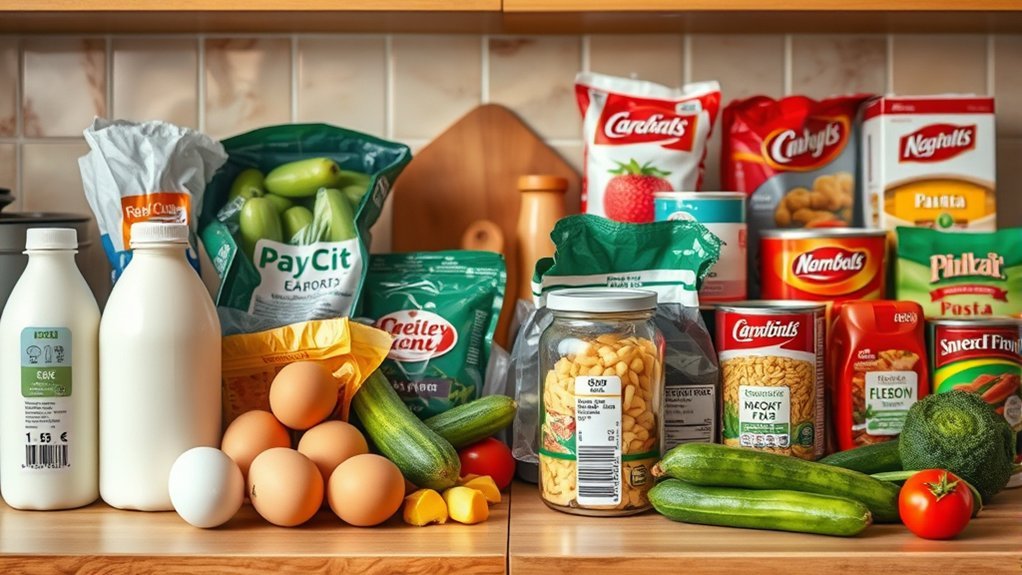You might think that expiration dates are a straightforward indicator of food safety, but that’s not the whole story. Many consumers confuse these dates, leading to unnecessary waste. In fact, understanding the nuances of terms like “Sell By,” “Use By,” and “Best Before” can change how you approach food in your pantry. What if you could save money and reduce waste by simply reassessing those dates? Let’s explore the facts behind these commonly misunderstood labels.
Understanding Expiration Dates: What Do They Really Mean?
While you might think expiration dates indicate a hard cut-off for food safety, they actually convey more nuanced information. These dates often represent the manufacturer’s estimate of peak quality rather than an absolute safety deadline.
Research shows that many foods remain safe to consume well past these dates, provided they’ve been stored properly. For instance, canned goods can last for years beyond their marked dates, as long as the packaging remains intact.
Understanding this distinction can help you minimize food waste and save money. However, always assess the food’s appearance, smell, and texture before consuming.
The Different Types of Dates: Sell By, Use By, Best Before
Understanding the nuances of expiration dates is essential for making informed choices about food safety. The terms “Sell By,” “Use By,” and “Best Before” serve distinct purposes.
“Sell By” indicates the last date a retailer should display a product for sale, ensuring freshness. It’s not a safety date, so you can consume items shortly after this date if stored correctly.
Sell By dates inform retailers when to remove products from shelves, but items can still be safe to consume shortly after.
“Use By” is a safety guideline for perishable items, indicating the last date for peak quality and safety. Consuming after this date isn’t recommended.
Finally, “Best Before” suggests when the product is likely to be at its best quality. While these dates can guide your decisions, they don’t always reflect the actual safety of the food. Always use your senses in conjunction.
Common Myths About Expiration Dates Debunked
Many people mistakenly believe that expiration dates are absolute indicators of food safety, leading to unnecessary waste and confusion. Understanding the myths surrounding these dates can help you make more informed choices.
Here are four common misconceptions:
- All food is unsafe after the expiration date: Many items remain safe to consume beyond this date, especially if stored properly.
- Expiration dates are regulated: In fact, many are set by manufacturers based on quality, not safety.
- Smell and taste are reliable indicators: While these can help, they aren’t foolproof for food safety.
- You can’t consume canned goods after the date: Canned food often lasts years past its date if the can is intact.
How Expiration Dates Are Determined: The Science Behind Them
Expiration dates are determined through a combination of scientific testing and industry standards that assess food safety and quality.
Manufacturers conduct stability tests, monitoring how food products change over time regarding taste, texture, and nutritional value. These tests often involve storing products under various conditions to replicate real-world scenarios.
Microbial testing is essential, as it identifies potential pathogens that could compromise safety. Regulatory agencies, like the FDA, provide guidelines that help standardize these practices.
Additionally, factors such as packaging, storage conditions, and ingredient composition play significant roles. Ultimately, expiration dates reflect a product’s ideal quality period, but they don’t always indicate immediate spoilage after that date.
Understanding this process empowers you to make informed decisions about food consumption.
Safe Practices for Consuming Food Past Expiration Dates
You might be surprised to learn that consuming food past its expiration date can be safe, provided you follow certain practices.
Start by evaluating the food’s condition before deciding to eat it. Here are four key practices to guarantee safety:
- Check for Signs of Spoilage: Look for unusual odors, colors, or textures.
- Consider the Type of Food: Dry goods often last longer than perishable items like dairy or meat.
- Use the Smell Test: If it smells fine, it’s usually safe, but trust your instincts.
- Cook Thoroughly: Heat food to safe temperatures, which can kill many harmful bacteria.
Frequently Asked Questions
Can I Trust My Senses to Judge Food Safety?
You can trust your senses to a degree, but they aren’t foolproof. Visual cues, smell, and texture help, yet they can’t guarantee safety. Always combine your observations with proper food storage practices for best results.
Do Expiration Dates Apply to All Food Products?
No, expiration dates don’t apply to all food products. They mainly concern perishables, while shelf-stable items might have different guidelines. Always check specific labels and understand the product’s nature for accurate food safety assessment.
How Do Manufacturers Decide on Expiration Dates?
Think of manufacturers as chefs crafting recipes; they combine scientific testing, shelf-life studies, and safety regulations to determine expiration dates. These dates reflect the product’s ideal quality and safety for consumers like you.
Are Organic Products Subject to Different Expiration Dates?
Yes, organic products often have different expiration dates due to their lack of synthetic preservatives. Their shorter shelf life requires careful handling and proper storage to guarantee freshness and safety compared to conventional items.
What Should I Do With Expired Food Items?
You should assess the food’s appearance, smell, and texture. If it looks and smells fine, it’s likely safe. However, when in doubt, discard it to avoid potential foodborne illnesses and guarantee your safety.
Conclusion
By understanding expiration dates and the myths surrounding them, you can make smarter choices and reduce food waste. Remember, those dates often reflect quality, not safety. Trust your senses—sight, smell, and taste—when evaluating food. Think of expiration dates as guidelines, not guardrails; they can help navigate your food decisions without steering you toward unnecessary waste. With this knowledge, you can confidently enjoy your food beyond the date, ensuring both safety and sustainability.
